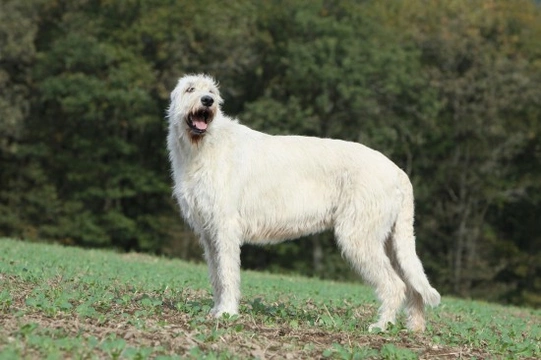
Irish wolfhound hereditary health and genetic diversity
The Irish wolfhound is most notable for being the tallest of all of the dog breeds in the world, and rather than having a maximum height range imposed by the breed standard, the Irish wolfhound actually has a minimum! Males should stand at least 32” tall at the withers when adult, with females being over 30”, with a minimum weight of 120lb for males and 105lb for females. However, in practice, there is not a huge range of variance between male and female sizes, and most females of the breed stand well north of 30” high themselves.
The Irish wolfhound is a sighthound breed, with a build in line with that of most sighthound dogs; long legged with a body that is relatively lean compared to their height, with a deep, broad chest. Their coats are medium length and rough and shaggy, and can be seen in a wide range of colours including black, grey, white, red and brindle.
Historically used as a hunting sighthound for working roles, today, the Irish wolfhound is much more commonly owned as a pet. If you have the room to take on a giant dog breed like the Irish wolfhound, they do make an excellent choice for all types of homes, and are calm, loving and generally quiet when indoors.
If you are considering buying or adopting an Irish wolfhound, it is of course vital to do plenty of research on the breed before you commit to a purchase. In this article, we will look at the hereditary health and average longevity of the Irish wolfhound in more detail.
Irish wolfhound longevity
The average lifespan of the Irish wolfhound is just 7 years, according to a Kennel Club survey of owners of dogs of the breed. While 7 years of age is obviously much shorter than the average lifespan of most dog breeds, large and giant breeds do tend to be much shorter lived than their smaller counterparts, and even so, it is not unknown for dogs of the breed to live above this age.
Genetic diversity
The coefficient of inbreeding statistic for the Irish wolfhound breed as a whole is 5.3%, which is slightly below the figure of 6.25% or less that is considered to be optimum for pedigree dog breeds. This indicates that the Irish wolfhound is not subjected to a high degree of inbreeding, and ensures the ongoing genetic diversity of the breed.
Conformation
The shape, build and sheer size of the Irish wolfhound does mean that the breed has elevated risk factors for a couple of health problems caused by their build, which owners should be aware of. These are:
- Bloat, or gastric torsion, a condition caused by a dangerous build-up of stomach gas, which may cause the stomach to flip over on itself. This condition is most common in large, deep chested breeds such as the Irish wolfhound.
- Elbow dysplasia, caused by a malformation of the joint of the elbow, possibly due to the large size of dogs of the breed.
Health testing for Irish wolfhounds
There are a reasonably wide range of health tests and health schemes advised for the Irish wolfhound, in order to monitor the health of the breed and ensure its ongoing improvement. Current tests and schemes available include:
- Hip score testing, with the mean score for the breed as a whole being 6. Breeders should seek only to breed dogs with a hip score below this number.
- Testing for elbow dysplasia, with the ideal score being zero.
- Eye tests for various hereditary eye diseases, including multifocal retinal dysplasia, and progressive retinal atrophy.
- DNA testing is available for hyperekplexia, a neurological disorder.
Irish wolfhound breed organisations also recommend the following tests and advisories for the breed too:
- Heart testing on an annual basis.
- Testing of puppies of the breed for portosystemic shunt, a condition of the liver.
- Bitches under the age of two or over the age of six should not be used for breeding.
- Bitches should not produce more than one litter within any 12 month period.
Other health issues
There are also various other health issues identified across the breed that have a hereditary factor to them, but for which no pre-breeding screening is currently available. These include:
- Dilated cardiomyopathy, a weakness of the heart muscles leading to heart failure.
- Osteosarcoma, or bone cancer.
- Epilepsy, although this can often be managed with medication. Epileptic dogs should not be bred from.
- A propensity to rhinitis and possibly pneumonia, a bacterial infection of the lungs.
- Wobbler syndrome, caused by the compression of the spinal cord, leading to loss of coordination in the hind legs.
- Von Willebrand’s disease, a blood clotting disorder.
- Entropion of the eyelids, which causes the eyelids to fold inwards and rub on the eyeball.
- Panosteitis, an inflammatory condition of the bones.
- Cataracts, although these are often operable.
- Autoimmune disorders.



